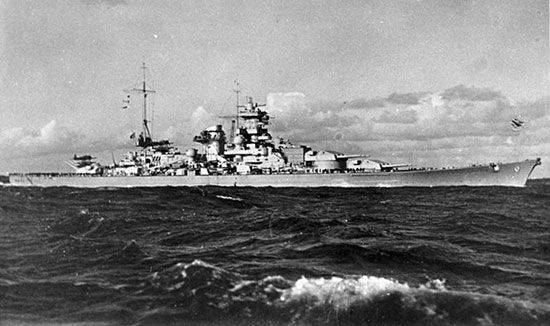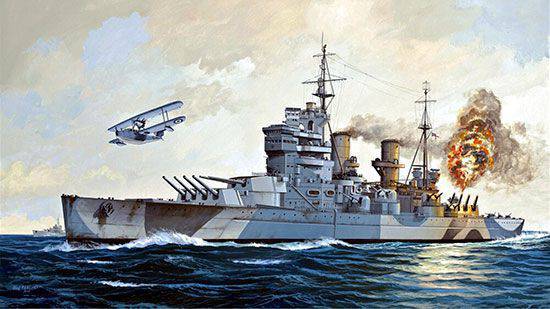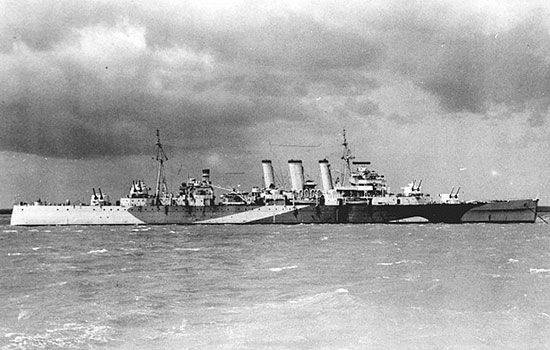Fight off Cape North Cape 25-26 December 1943
The first allied convoy, consisting of six transports, arrived in Arkhangelsk on September 1. The Wehrmacht’s main command did not cause this particular concern, since it believed that the supply of arms, military equipment and materials to the USSR could no longer influence the general course of the war. Until the end of 1941, the Allies conducted thirteen convoys in both directions. At the same time, about 750 were delivered to Arkhangelsk and Murmansk tanks, 800 aircraft, 1400 vehicles and more than 100 tons of ammunition, industrial equipment, strategic raw materials, food and other cargoes.
As the failure of the “blitzkrieg” war plan became more and more obvious, the military-political leadership of Germany was forced to change its attitude toward the Allied convoys. In the middle of November, 1941, A. Hitler decided to relocate the strongest warships krigsmarine (Navy) to the Arctic. The creation of the Nord naval grouping was completed by the spring of 1942. It included the battleship Tirpitz, the heavy cruisers Admiral Scheer, Lutz, Admiral Hipper, Prince Eugen, the Cologne light cruiser, two fleet destroyers, up to 20 submarines. The task of disrupting the Arctic communication between the British Isles and the USSR was also assigned to the command of the 5 fleet of the Luftwaffe, whose aircraft were based on the airfields of Northern Norway.
The German armed forces inflicted the strongest blows on Allied navigation in the North in the summer of 1942, defeating the PQ-17 convoy and inflicting heavy damage on the PQ-18 convoy. Because of this (and according to the British military cabinet and in connection with preparations for the landing of the Anglo-American troops in North Africa), convoy operations were suspended, and the Soviet Northern Fleet was forced to confront the powerful Arctic naval grouping of the enemy without the help of allies. By that time there were only nine destroyers in it. By total firepower (25 - 130-mm, 12 - 102-mm, 8 - 76,2-mm, 3 - 45-mm guns), for example, they were inferior to a single German heavy cruiser Lutz (6 - 280-mm, 8 - 150-mm, 6 - 103-mm guns).
In an effort to maximize the use of a favorable environment, the command of the kriegsmarine conducted an operation "Wunderland" in August of 1942. During its course, the heavy cruiser “Admiral Scheer” sank the icebreaking steamer and fired at the port of Dickson, damaging the patrol ship and transport. However, the enemy did not succeed in completely interrupting Allied shipping in the North. With the onset of the polar night movement of the convoys resumed.

In the spring of 1943, the German command sent the battleship Scharnhorst to Northern Norway to replace the two cruisers transferred to the Baltic. However, until the fall, the battleships remaining in the ranks were virtually inactive, as the British Admiralty again suspended the movement of the convoys. The only joint exit "Tirpitz" and "Scharnhorst" was held in the first half of September, but the result of their artillery fire on the coastal facilities on the Svalbard archipelago was negligible. 22 September 1943, the British ultra-small submarines heavily damaged the Tirpitz. The next day, the heavy cruiser Lutzov left for repair in Germany. Such a serious weakening of the grouping of the German Navy in the Arctic and problems with the provision of fuel remaining in the ranks of the ships called into question the expediency of its continued existence. In this regard, the command of the kriegsmarine was forced to look for a case in order to prove the opposite.
Meanwhile, in November 1943, the movement of the Allied Arctic convoys resumed. Until the end of the year, four convoys were conducted in both directions. For example, in December, two convoys were simultaneously deployed, which followed each other: RA-54B - from the USSR to the West and JW-55A - in the opposite direction. Their immediate operational cover was carried out by Rear Admiral R. Barnett's compound, consisting of two Belfast and Sheffield light cruisers of the same type and the Norfolk heavy cruiser (the so-called "Washington type"), the long-range operational cover — by a compound that included a battleship The Duke-of-York (under the flag of Metropolitan Fleet Commander Admiral B. Frazer), the Jamaica light cruiser and four destroyers of the destroyer.
Aviation the enemy found the convoy RA-54B on December 23, 1943 in the Faroe Islands. But, having performed on it only one unsuccessful air attack, the pilots lost it. Two days later, the same convoy was discovered by a German U-601 submarine. However, successive attempts at the beginning of this boat, and then the U-716 to attack transports were thwarted by security ships. Then Admiral K. Dönitz decided to strike a convoy with surface ships. The battleship Scharnhorst (the flag of Rear Admiral E. Bey) and five destroyers (Z-29, Z-30, Z-33, Z-34, Z-38) came to intercept him ").

On the morning of December 26, the German compound spread out in the area between Bear Island and North Cape to increase the search bandwidth. At that moment, Rear Admiral E. Bey did not know that British radio intelligence had intercepted and deciphered his radio communications talks. Meanwhile, the British ships have already begun the hunt for the Scharnhorst. The battleship "Duke of York" with a cruiser and four squadron destroyers followed to the area from the west, and from the east cruiser R. Barnett approached it. It was they who first discovered the enemy battleship, having established a radar contact with him at a distance of 17,5 miles (33 km). The Scharnhorst radars were turned off: in this way, E. Bey hoped to achieve surprise when the convoy attacked.
The battle between the Scharnhorst and the British cruisers began in 9 hours 25 minutes. The first volley of lighting shells produced a light cruiser "Belfast". A minute later, the 203-mm guns of the heavy cruiser "Norfolk" opened fire. One of the shells destroyed the antenna of the radar station of the German ship. After that, the fire control of two towers of its main caliber could only be carried out according to data obtained with the help of optical rangefinders, which in the conditions of the polar night was almost equivalent to shooting blindly. But the excitement of the sea did not allow the British cruisers to develop the most complete course, and the Scharnhorst managed to break away from them.

The German battleship again lay on the course, which led to the area where, according to calculations, there could be an Allied convoy. However, around noon, the Scharnhorst was again pinned by the Belfast radar. After about 20 minutes, the fight resumed. This time the German ship, whose artillery was stronger than the artillery armament of the entire R. Barnett unit, achieved several hits at the Norfolk. One of the four towers of the main caliber of the British cruiser was disabled. Despite the success achieved, the German flagship, while still pursuing the goal of defeating the convoy, evaded further fire contact and, ordering its squadron destroyers to resume the search for an allied caravan, sent the Scharnhorst to the southeast. At the same time, he did not know that the chosen course leads towards the formation under the command of Admiral B. Frazer.
At about 13 hours 15 minutes due to ambiguity of the situation E. Bey nevertheless canceled his decision and ordered to return to the base. The remaining Scharnhorst aft radar was switched off again to make it more difficult for enemy ships to detect. Two hours later, a radiogram was sent to the shore from the German battleship, in which E. Bey called the estimated time of his return. He did not guess that the cruisers of R. Barnett "led" his flagship, maintaining continuous radar contact with him, and the RA-55B long-range operational cover was directed at him.
The fight resumed at 16 hours 47 minutes. The British light cruiser "Belfast" and the battleship "Duke-of-York" were the first to open fire with lightning shells. The Scharnhorst responded with a major caliber, but its 283-mm projectiles did not pierce the armor covering the vital parts of the enemy’s battleship. Soon, on the German battleship itself, one was damaged and another nose tower was damaged. In addition, 356-mm projectile struck the board in the area of the main caliber aft turret. But for this ship, which had a developed protection system, all this was not fatal.
Taking advantage of the speed, E. Bey sought to increase the distance of the battle, and as long as he succeeded, the British destroyers could not carry out the order of their flagship on the attack with torpedoes. By 17 42 minutes, the distance between the Scharnhorst and the English ships increased so much that only Duke-of-York and only the main caliber could fire at it.
Despite the significant removal of the target, the shooting of the British battleship, controlled by radar data, was accurate. Around 18 hours 20 minutes 356-mm projectile exploded under the first boiler room of the German ship, and its speed dropped to 8 nodes. The measures to repair the damage were taken quickly, after which the Scharnhorst was even able to increase the speed to 22 units, but by that time it had already lost most of its artillery. In 18 hours 24 minutes the last radiogram was sent from him: "We will fight until the last round."
A quarter of an hour later, the Duke-of-York guns temporarily stopped firing, and Admiral B. Frazer re-ordered the destroyers to make a torpedo attack. This time they managed to get close to the Scharnhorst at a distance of volley. After hitting four torpedoes, the speed of the latter did not exceed 12 nodes. Having reduced the distance to 9,1 km, Duke-of-York again opened fire on him with 356-mm guns. When the speed of the enemy ship fell to 5 nodes, and it almost ceased to obey the helm, B. Frezer ordered to complete his destruction with torpedoes. In the course of 20 minutes, the Schnhorst launched 27 torpedoes, of which seven reached the target. In 19 hours 45 minutes after a powerful internal explosion, the German battleship engulfed in flames went under water. Of the 1968 people on board, the English sailors saved only 36.
Having received the news of the battle at Cape Nordkap, I.V. Stalin sent a message of congratulations to British Prime Minister William Churchill, Commander of the Metropolitan Fleet, Admiral B. Frezer and the "valiant sailors" of the Duke-of-York battleship. Perhaps it was the only case in the whole of World War II, when the tactical, from a formal point of view, success of the Allies received such high appreciation from the mouth of the first person of the Soviet state.
After the death of the Scharnhorst, the British military cabinet stopped viewing the Kriegsmarine’s Arctic grouping as a fatal threat to the northern convoys. Their movement is not interrupted. There was no need to bring the main forces of the fleet to conduct convoy operations, so that the British Admiralty could withdraw from its composition and send an aircraft carrier, two battleships and a battle cruiser to the Pacific Ocean. This was the military-political and military-strategic importance of the victory won by the Allied naval forces of December 26 1943.
The battle in the Barents Sea showed that organizing the escorting of convoys in the form of an operation, in which all types of forces of the Allied fleets were involved, was the most expedient decision. On the other hand, the attempt to strike at the Allied convoy, which was not supported by either intelligence or operational camouflage measures, failed completely naturally. The reliance on the high maneuverability characteristics of ships of the type to which the Scharnhorst belonged (as well as the battle cruisers in general) proved to be untenable. In the armed struggle at sea, the range, accuracy and power of the means of destruction acquired decisive importance, and shipborne radiolocation, originally intended primarily to cover the situation, became the main means of controlling artillery fire.
Information